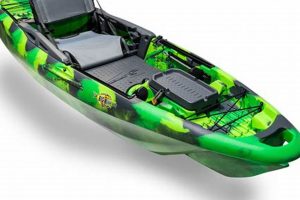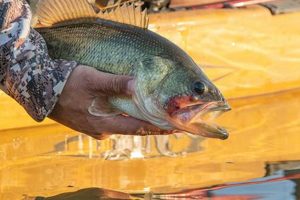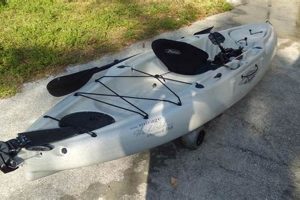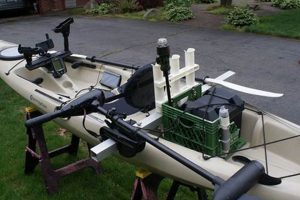Compact, sit-on-top vessels designed for angling in calm waters, these shorter kayaks offer excellent maneuverability and portability. Their reduced length makes them easier to transport and store, a significant advantage for anglers with limited space. Typically constructed from durable, lightweight materials like high-density polyethylene, they often feature specialized accessories such as rod holders, paddle clips, and storage compartments.
Shorter kayaks provide distinct advantages for fishing in smaller bodies of water like ponds, lakes, and slow-moving streams. Their nimble handling allows anglers to navigate tight spaces and access shallow areas often teeming with fish. The lighter weight contributes to easier launching and retrieval, reducing the physical demands of a fishing trip. Historically, smaller watercraft have played a crucial role in fishing cultures worldwide, demonstrating the enduring practicality of compact vessels for this purpose. Modern materials and manufacturing techniques have further enhanced their performance and durability.
This article will delve deeper into the various aspects of these specialized kayaks, exploring topics such as material selection, design features, stability considerations, and ideal fishing environments. Furthermore, it will address key factors to consider when choosing the right vessel for individual needs and preferences, equipping readers with the knowledge to make informed decisions.
Tips for Utilizing Compact Fishing Kayaks
Proper utilization of shorter fishing kayaks maximizes their advantages and ensures angler safety and enjoyment. These tips offer guidance for effective use in appropriate environments.
Tip 1: Prioritize Stability: Due to their shorter length, maintaining balance is crucial. Distribute weight evenly and avoid sudden movements. Practice entering and exiting the kayak in shallow water before venturing further.
Tip 2: Choose Calm Waters: These kayaks are best suited for calm lakes, ponds, and slow-moving rivers. Avoid open water, strong currents, and challenging weather conditions.
Tip 3: Maximize Storage Efficiently: Limited storage space necessitates careful planning. Prioritize essential gear and utilize dry bags to protect equipment from water.
Tip 4: Select Appropriate Paddles: Shorter paddles are generally recommended for maneuverability in compact kayaks. Consider adjustable paddles for customized comfort and efficiency.
Tip 5: Utilize a Kayak Cart: Transporting short kayaks to and from the water is simplified with a kayak cart. This reduces strain and potential damage to the vessel.
Tip 6: Regularly Inspect and Maintain: Routine checks for wear and tear, especially on hull and fittings, are essential. Proper maintenance prolongs the kayak’s lifespan and ensures safe operation.
Tip 7: Consider a Rudder or Skeg: While not always necessary, a rudder or skeg can enhance tracking and control, especially in windy conditions.
Tip 8: Practice Paddle Strokes: Mastering basic paddle strokes improves efficiency and maneuverability. Practice different strokes for turning, forward movement, and reverse.
By adhering to these guidelines, anglers can enhance their fishing experience while ensuring safety and maximizing the benefits of shorter kayaks. Careful planning and mindful execution contribute to a successful and enjoyable outing.
In conclusion, understanding the advantages and limitations of shorter fishing kayaks allows anglers to leverage their unique characteristics for an optimal fishing experience. The following section will summarize key takeaways and offer final considerations.
1. Maneuverability
Maneuverability represents a defining characteristic of 8-foot fishing kayaks, significantly influencing their suitability for specific fishing environments. The ability to navigate tight spaces and change direction efficiently dictates the kayak’s effectiveness in accessing prime fishing locations.
- Turning Radius
A smaller turning radius allows for quick adjustments in direction, crucial for navigating around obstacles like fallen trees or emergent vegetation. This agility proves advantageous in confined areas, enabling precise positioning for optimal casting angles.
- Paddle Responsiveness
The kayak’s responsiveness to paddle strokes directly impacts maneuverability. Efficient transfer of paddle power into directional change contributes to precise control. This responsiveness becomes particularly important in dynamic fishing situations requiring immediate adjustments.
- Hull Design Influence
Hull design plays a pivotal role in maneuverability. Shorter kayaks often feature flatter hulls, contributing to increased agility. However, this design choice can influence stability, necessitating careful consideration of the balance between maneuverability and stability.
- Impact of Water Conditions
While inherent maneuverability is determined by design, external factors like current and wind can significantly impact performance. Shorter kayaks, due to their smaller size, can be more susceptible to these influences, requiring additional paddling effort for maintaining intended course and position.
The interplay of these facets dictates the overall maneuverability of an 8-foot fishing kayak. Understanding these factors empowers informed decisions, ensuring alignment between kayak selection and the intended fishing environment. Effective maneuverability contributes significantly to accessing productive fishing spots and optimizing angling success in smaller, confined waters.
2. Portability
Portability represents a significant advantage of 8-foot fishing kayaks, directly influencing their ease of transport and storage. This characteristic expands accessibility for anglers with limited storage space or transportation capabilities, broadening opportunities for diverse fishing experiences.
- Reduced Weight
The compact size translates to a lower overall weight compared to longer kayaks. This reduced weight simplifies handling, requiring less physical exertion during transport to and from the water. This ease of handling is particularly beneficial for individuals with physical limitations or those accessing remote fishing locations.
- Compact Dimensions
The shorter length allows for easier storage in smaller spaces, such as apartments, garages, or vehicle interiors. This compact footprint reduces storage constraints, eliminating the need for specialized storage solutions often required for longer kayaks. This practicality enhances accessibility for individuals without dedicated storage areas.
- Simplified Loading and Unloading
The lighter weight and shorter length simplify the process of loading and unloading onto vehicle roof racks or trailers. This ease of handling minimizes the time and effort required for transport, streamlining the pre- and post-fishing experience. This efficiency is particularly valuable for solo anglers.
- Car-Topping Feasibility
Many 8-foot kayaks are easily car-topped, eliminating the need for trailers and expanding transportation options. This flexibility enables access to a wider range of fishing locations, particularly those inaccessible by larger vehicles towing trailers. This adaptability enhances the versatility and overall utility of the kayak.
The convergence of these portability factors enhances the overall appeal of 8-foot fishing kayaks, particularly for anglers prioritizing ease of transport and storage. This inherent portability expands fishing opportunities, enabling access to a wider variety of locations while accommodating diverse storage limitations. This practicality directly contributes to the growing popularity of these compact fishing platforms.
3. Stability
Stability in 8-foot fishing kayaks presents a critical consideration, directly influencing angler safety and fishing effectiveness. The shorter hull length inherently reduces stability compared to longer kayaks, necessitating careful consideration of design features, weight capacity, and individual angler balance. Understanding the factors influencing stability is crucial for informed kayak selection and safe operation on the water.
Primary stability, the initial resistance to tipping, is significantly impacted by hull width and shape. Wider, flatter hulls generally offer greater primary stability, providing a more secure platform for casting and reeling. However, this can compromise maneuverability. Secondary stability, the resistance to capsizing once tilted beyond the initial point of resistance, is influenced by hull design features such as chines and rocker. Pronounced chines and moderate rocker can enhance secondary stability, providing a reassuring level of resistance to complete capsizing. Weight distribution within the kayak also plays a crucial role. Evenly distributing gear and maintaining a low center of gravity enhances stability, reducing the likelihood of tipping. For example, placing heavier items closer to the center of the kayak and avoiding sudden shifts in weight improves overall balance. Anglers exceeding the kayak’s recommended weight capacity compromise stability, increasing the risk of capsizing. Selecting a kayak with an appropriate weight capacity is paramount for safe operation.
Prioritizing stability when choosing an 8-foot fishing kayak is essential for a safe and enjoyable fishing experience. Understanding the interplay between hull design, weight capacity, and individual angler balance empowers informed decision-making. Investing time in practicing basic paddling and maneuvering techniques in calm, shallow water builds confidence and enhances on-the-water stability. Ultimately, a stable platform contributes to a more productive and enjoyable fishing outing, allowing anglers to focus on the sport rather than constantly battling to maintain balance.
4. Capacity Limitations
Capacity limitations represent a crucial consideration for 8-foot fishing kayaks, directly impacting gear storage, angler comfort, and overall fishing effectiveness. These limitations stem from the inherent size and design of these compact vessels. Understanding these constraints enables informed decisions regarding gear selection, fishing locations, and overall trip planning.
Reduced storage space necessitates careful prioritization of essential fishing gear. Anglers must make informed choices regarding tackle, rods, and other equipment, balancing necessity against available space. Larger items, like tackle boxes or coolers, may require downsizing or alternative storage solutions, such as dry bags secured to deck rigging. Weight capacity restrictions further influence gear selection and angler comfort. Exceeding the maximum weight capacity compromises stability and performance, potentially leading to safety concerns. Anglers must consider their own weight in addition to gear and potential catch weight when assessing capacity limitations. Attempting to carry excessive weight can lead to a less stable and less efficient paddling experience, potentially impacting maneuverability and safety. Limited space within the cockpit can also impact angler comfort, particularly for larger individuals or longer fishing trips. The confined space may restrict legroom and movement, potentially leading to discomfort or fatigue. Careful consideration of cockpit dimensions and angler size is crucial for ensuring a comfortable and enjoyable fishing experience.
Recognizing and adapting to capacity limitations inherent in 8-foot fishing kayaks is essential for maximizing their effectiveness and ensuring angler safety. Careful planning, gear selection, and realistic expectations regarding storage and comfort contribute to a more productive and enjoyable fishing outing. Understanding these limitations empowers anglers to make informed decisions and optimize their experience on the water, maximizing the benefits of these compact and versatile fishing platforms.
5. Targeted Use Cases
Targeted use cases for 8-foot fishing kayaks are dictated by the vessel’s inherent design characteristics, including size, maneuverability, and capacity limitations. Understanding these specific applications maximizes the kayak’s effectiveness and ensures angler safety and enjoyment. Matching the kayak to appropriate environments optimizes fishing success and overall experience.
- Small, Calm Waters
Calm lakes, ponds, and slow-moving streams represent ideal environments. The kayak’s maneuverability excels in these confined spaces, allowing anglers to navigate tight areas and access shallow-water habitats. The shorter length provides nimble handling, enhancing responsiveness to paddle strokes and facilitating precise boat control in these often vegetated areas.
- Protected Coastal Areas and Bays
Sheltered bays and estuaries with minimal current and wave action offer suitable fishing opportunities. However, careful attention to wind conditions and tidal changes is crucial. While manageable in calm conditions, these kayaks are not designed for open ocean or exposed coastal areas subject to strong winds, currents, or significant wave action. Prioritizing safety requires careful assessment of environmental conditions and adherence to conservative limitations.
- Short-Distance Paddling
These kayaks are best suited for shorter paddling distances due to their limited storage capacity and potential for angler fatigue. Longer trips necessitate careful consideration of gear storage, angler comfort, and potential exposure to changing weather conditions. Focusing on shorter excursions maximizes enjoyment and minimizes potential discomfort associated with limited space and potential fatigue from paddling a shorter kayak over extended distances.
- Specific Fishing Techniques
Certain fishing techniques, such as still fishing, spin casting, and fly fishing in calmer waters, align well with the kayak’s design and maneuverability. Trolling, however, presents limitations due to reduced tracking ability and susceptibility to wind and current influences. Understanding these limitations allows for informed technique selection, maximizing effectiveness and optimizing fishing success within the kayak’s capabilities.
Recognizing the targeted use cases for 8-foot fishing kayaks ensures angler safety and maximizes the vessel’s effectiveness. Matching the kayak to appropriate environments and fishing techniques enhances overall enjoyment and success on the water. Understanding these limitations empowers informed decision-making and promotes responsible kayak usage within its intended design parameters.
6. Affordability
Affordability frequently positions 8-foot fishing kayaks as an attractive entry point into the sport. Lower manufacturing costs associated with reduced material usage contribute to their generally lower price point compared to longer kayaks. This accessibility expands the market reach, allowing a wider range of individuals to experience kayak fishing without a substantial initial investment. For example, budget-conscious anglers or those seeking a secondary vessel for smaller water bodies often find 8-foot models a cost-effective solution. This price advantage allows individuals to explore the sport and assess their long-term interest before committing to a more significant investment in a larger, more feature-rich kayak. Furthermore, the lower cost often extends to related accessories, such as paddles and life vests, further reducing the overall financial barrier to entry.
The affordability of these kayaks can also influence purchasing decisions among experienced anglers seeking specialized vessels for specific fishing scenarios. The lower cost allows for ownership of multiple kayaks tailored to different environments or fishing styles without a prohibitive financial outlay. An angler might own a larger, more stable kayak for open water fishing and a smaller, more maneuverable 8-foot model for navigating creeks and tight spaces. This specialized approach enhances fishing versatility while remaining budget-conscious. However, it is important to note that while affordability is a significant advantage, it can sometimes correlate with reduced features or durability. Careful consideration of construction materials, included accessories, and intended use is crucial to ensure the chosen kayak meets individual needs and expectations despite the lower price point. Balancing cost against features requires careful evaluation and prioritization.
Ultimately, the affordability of 8-foot fishing kayaks plays a significant role in their popularity and market appeal. This accessibility broadens participation in the sport, attracting both newcomers and experienced anglers seeking specialized solutions. However, potential trade-offs related to features and durability necessitate careful evaluation and informed decision-making. Understanding the balance between cost and performance empowers consumers to select the kayak that best aligns with their individual needs, budget, and intended fishing applications.
Frequently Asked Questions
This section addresses common inquiries regarding 8-foot fishing kayaks, providing concise and informative responses to facilitate informed decision-making.
Question 1: Are 8-foot kayaks suitable for ocean fishing?
Generally, 8-foot kayaks are not recommended for open ocean fishing due to their limited stability and susceptibility to wind and waves. They are better suited for calm, protected waters.
Question 2: What is the typical weight capacity of an 8-foot fishing kayak?
Weight capacity varies depending on the specific model and manufacturer, but typically ranges from 200 to 300 pounds, including angler weight and gear.
Question 3: Can one stand up in an 8-foot fishing kayak?
Standing in an 8-foot kayak is generally discouraged due to its shorter length and lower stability compared to longer models. It increases the risk of capsizing.
Question 4: What essential features should one look for in an 8-foot fishing kayak?
Essential features include rod holders, storage compartments, comfortable seating, and durable construction materials. A rudder or skeg can also enhance maneuverability.
Question 5: How does one transport an 8-foot kayak?
Due to their compact size, 8-foot kayaks can often be car-topped using roof racks or transported in the bed of a pickup truck. Specialized kayak trailers are also available.
Question 6: Are 8-foot fishing kayaks suitable for beginners?
Their maneuverability and affordability can make them a suitable option for beginners in calm, protected waters. However, practicing basic paddling skills before venturing out is essential.
Careful consideration of individual needs, intended fishing environments, and kayak specifications is crucial for making informed purchasing decisions. Understanding the limitations and advantages of 8-foot kayaks ensures a safe and enjoyable fishing experience.
This concludes the FAQ section. The following section will provide a comprehensive comparison of various 8-foot fishing kayak models available on the market.
Conclusion
8-foot fishing kayaks offer a specialized approach to angling, particularly suited to calm, confined waters. Their maneuverability and portability represent significant advantages for navigating tight spaces and accessing shallow areas often rich in fish populations. Affordability expands accessibility, making them an attractive entry point for newcomers to the sport. However, capacity limitations and stability considerations require careful evaluation. Understanding the inherent trade-offs between size, stability, and capacity empowers informed decision-making, ensuring appropriate kayak selection aligned with individual angler needs and intended fishing environments. Careful consideration of hull design, weight capacity, and storage features ensures an optimal balance between performance and practicality.
The selection of a fishing kayak remains a deeply personal decision, influenced by individual fishing styles, target species, and preferred environments. 8-foot kayaks occupy a distinct niche within the broader kayak fishing landscape, catering to specific needs and preferences. Thorough research and thoughtful consideration of the factors discussed herein empower informed choices, contributing to enhanced fishing experiences and fostering a deeper appreciation for the versatility offered by these specialized vessels.






